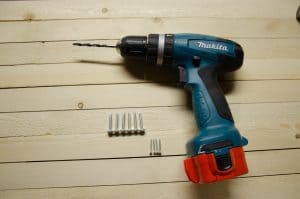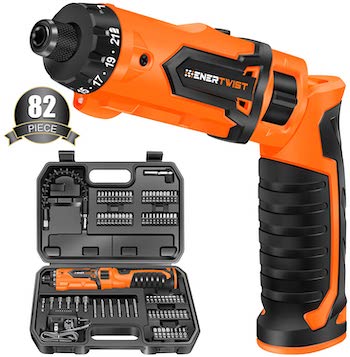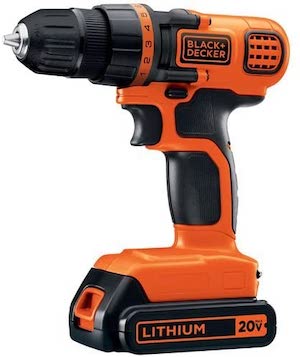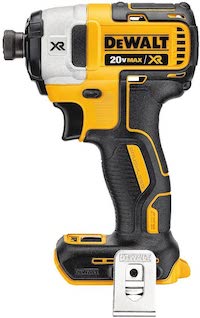What’s The Difference Between a Cordless Drill and Electric Screwdriver?
Recently during a DIY project around the house, I found myself in need of a tool with more power than what my manual screwdriver and forearms could muster. I started looking into what the ideal addition to my toolbox should be, an electric screwdriver or drill?
To make the best decision, I first had to learn what is the difference between an electric screwdriver and a drill? The most significant difference between these tools is the motor size and battery voltage (v) needed to power them. Electric screwdriver motors are much smaller, most commonly requiring between 4v and 10v to operate, thus producing much less torque. Cordless drills have larger motors and in turn, need more battery voltage to run. Another difference is the gripping church that is often found on the electric drill. The chuck allows the drill to be more flexibility when accepting a variety of bits.

Many models of drills use 12v to 18v batteries that can handle most common household tasks or the 20v to 24v batteries geared toward more industrial or commercial jobs. Electric screwdrivers and drills are different tools but they do have some overlap in function. Making the best choice depends on the task at hand and the scope of projects you plan to use them for in the future.
Here’s the key information about drills vs electric screwdrivers that will help you choose the best tool for your project!
Electric Screwdrivers Benefits:
- Tend to be much smaller hence being more capable of fitting into tight spaces (i.e. electrical boxes) and working on projects smaller screws.
- These can be equipped with angled drive heads improving maneuverability when dealing with awkward angles.
- Less torque can be beneficial when working on softer woods or materials that tend to splinter or crack.
- It can easily remove a stripped screw
- Smaller motors are lighter and improve portability. Electric screwdrivers fit easily into most tool belts or even a roomy pocket.
- Can be especially beneficial to someone suffering from a lack of grip strength, arthritis or other medical condition that may not be able to use a manual screwdriver and are not comfortable with the bulk of a cordless drill.
Example of an Electric Screwdriver
Cordless Drill Benefits:

- Much more powerful motors make them capable of handling any screw driving tasks such as one using very hardwood, metals or even concrete, increasing their versatility.
- Cordless drills can create or start the hole for a screw where one is needed regardless of the material.
- With certain attachments drills can be used for buffing, sanding, stirring paint and even cleaning drains (source).
- More likely to be able to remove screws that are old, rusted or compromised such as ones you might encounter in a remodel or rehab project.
Example of a Cordless Drill
Battery Life for Cordless Drills and Electric Screwdrivers
Both tools are most commonly equipped with lithium-ion batteries because they can provide more power with a traditionally smaller size and can be recharged multiple times.
Two important factors to consider when considering a cordless tool are the voltage and amp-hour rating. The voltage(v) rating of a battery is a measurement of how much power that battery can provide. Amp-hour (AH) ratings determine how long a battery holds a charge during use.
These AH ratings differ depending on the manufacturer and application but work as general indicators when comparing similar products such as cordless drill and electric screwdrivers. More intense applications will benefit from batteries with higher AH ratings, allowing for longer use with less frequent recharging.

For example, when comparing drills that both offer a 12v battery but one has a 1.3AH and 3AH, the 3AH will allow for longer operating time before running out of juice.
Another factor to consider when comparing drills to electric screwdrivers in terms of the batteries is where they are and how they are charged.
The batteries in a large variety of electric screwdrivers are contained in the tool itself, so the entire unit is plugged in to charge. This brings your project to a halt. Some higher-voltage electric screwdrivers and most cordless drills tend to have batteries that can be interchanged so there is no lag in work if a battery should die, just change out the depleted battery for a fresh one.
Whatever tool you plan on using for a large job, it is highly recommended that you have an extra battery on hand as part of your tool arsenal. Nothing is more frustrating than a dead battery with two screws left!
It is worth mentioning that there are small models of electric screwdrivers that can be powered by standard AA batteries, thus eliminating charging altogether.
Costs of Electric Screwdrivers and Cordless Drills
In terms of monetary cost vs. tool capability, electric screwdrivers don’t necessarily compare well with electric drills. The least expensive electric screwdrivers cost less than heavy-duty cordless drills, but more expensive screwdriver models typically cost more than inexpensive drills that are more powerful and more versatile.”
That versatility though does often require an extra battery and that is where the bulk of the cost of power drills comes from. It all comes down to choosing the right tool for the job, remember that bigger is not always better.
Comparing electric screwdrivers from popular hardware stores, the prices seem to be consistent across brands with comparable features.
The smallest electric screwdriver powered by AA batteries was the low end of the price range at $8.66. The highest-priced tools were those that had 12v batteries and came with extra accessories like travel cases or additional bits and costs between $90 and $105. The bulk of electric screwdrivers with chargers are moderately priced between $25 and $60.
Cordless drills have more variables when considering the price. The price does go up with the increased voltage but also as the amp-hour increases.
There are multiple manufacturers with options that would fit nearly every scenario and budget. The lower end of the price range for drills with a single battery is around $49. An example of the higher end was an 18v with 3.0AH for $122. For tackling most household remodeling tasks, look to spend between $60 and $90 for a drill with one battery and charger.
Beware very low priced items as they may be the drill only and not have the charger or battery included. There are also package deals that contain multiple tools, so make sure you do not pay for tools you don’t need.
One last note about a drill verse an electric screwdriver, the research for this comparison only took into consideration cordless options! Tools of this kind with cords have fallen out of favor due to safety concerns such as using them on ladders, needing multiple extension cords for access to outlets and being trip hazards. Also the improvements to lithium-ion batteries in run time, size and weight have led to the phasing out of cords in these types of tools.
Related Questions
What is an impact driver and what are its uses compared to a cordless drill/electric screwdriver?
While researching the previous topic I encountered another tool that does have some similar overlapping function and features but is at the opposite end of the spectrum from the electric screwdriver.
All are rotational tools and can have similar voltage options. An electric screwdriver is a tool more suited for precise and nuanced jobs than the cordless drill. On the reverse end, the tool to use when you need more muscle for a project than your cordless drill can offer is an impact driver.
Example of an Impact Driver
A cordless drill will maintain good control across a range of speeds and clutch setting and is perfect for more precise work like driving or setting screws across a range of materials. Then there are projects where more torque is required, like driving long lag bolts or taking lug nuts of your car, this is where the impact driver is useful.
Impact drivers also lack a clutch so they can fit into smaller spaces than a cordless drill. Another benefit is that the rotational force from an impact driver comes from the rotating striker inside the driver making it easy to hold.
The operator does not have to provide the counterforce to keep the tool from spinning like with a cordless drill. But because there is no clutch and it can exert such force, caution must be taken when you’re driving something that could be over-tightened or broken by the high torque. There are more limitations on the number of bits an impact driver can take and the ease at which it can them.
Making sure you understand the scope of the task you are trying to accomplish is the key to making sure you are making the correct choice in tools.
Looking for more tool recommendations? You can find all of our favorites here.
Related Questions
When should you use a manual screwdriver rather than an electric screwdriver or cordless drill?
There are occasions when a manual screwdriver is going to be your best and safest option. Anytime there could be volatile chemicals or explosive compounds present, manual screwdrivers will not cause excessive vibrations or create a spark. When there is a possibility of a chemical or biological contaminate a manual screwdriver is much easier to clean and sanitize.
Small manual screwdrivers are better suited for extremely delicate material or require a very precise amount of torque. Doing quick odd jobs, replacing a one-off random screw or a quick retightening the handy manual screwdriver in the junk drawer will probably suffice. Of course the only time a manual screwdriver will always be king is when all the batteries are dead.
Is an electric screwdriver or hand drill a better choice when trying to fit into a small area?
An electric screwdriver is typically going to be less bulky and easier to fit into tight areas.
Do I need an electric screwdriver if I already own a drill?
Most tasks that you can be completed with either tool. While it would be nice to have both the drill with be the more flexible choice for most projects.




